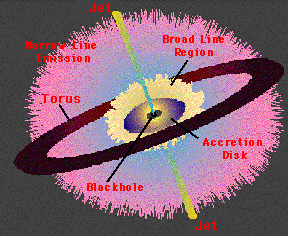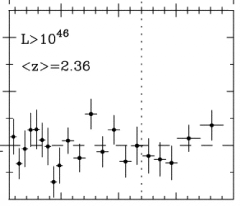Black Hole News Flash
The Yell of a Black Hole
| 04 December 1997 |

|
How fast are black holes at the centers of distant galaxies swallowing the matter around them? Using observations from the Japanese/NASA Advanced Satellite for Cosmology and Astrophysics (ASCA), Paul Nandra, Richard Mushotzky, and their research team have begun to shed some light on this question.
Black holes are not directly visible, so learning about them can be difficult. Scientists observing an X-ray emission line (specifically, the K-alpha line of iron) found it was an indicator of properties of the black holes found in the centers of active galactic nuclei (AGN). The emission line is generated by processes deep inside the accretion disk swirling around the massive black hole. "The indicator can be thought of as the final cry of doomed matter as it slides down the throat of a black hole," said Nandra.
The scientists used the Advanced Satellite for Cosmology and Astrophysics (ASCA) to observe the spectra of almost 40 AGN. These objects, which emit strongly in X-rays, are believed to harbor massive black holes at their cores, surrounded by rotating disks of gas. Friction slows the material in these accretion disks causing the material to spiral in closer and closer to the black hole. Eventually, it crosses inside of the event horizon of the black hole, the point of no return, and disappears from the known Universe.
Data from ASCA's Solid-state Imaging Spectrometer (SIS) showed that the iron line decreased in strength with increasing luminosity, and that the line actually disappeared for the most powerful AGNs (with luminosities greater than forty trillion times that of the Sun). ASCA's superior resolving power revealed that the shape of the emission line changed significantly as well: the lines had less of a red "tail" at higher luminosities. Both of these observations offer clues about the nature of the AGNs producing the emission.
 Spectrum from a Faint (Low Luminosity) AGN |
 Spectrum from a Bright (High Luminosity) AGN |
In the standard AGN model, the massive black hole is surrounded by an accretion disk and, outside of that, a thick torus. All three are then embedded inside a host galaxy of stars. One explanation for the results Nandra and his team observed is that the shape and strength of the observed emission line can vary depending on how much of the emission comes from the accretion disk and how much comes from the torus.
Nandra and colleagues suggested a second explanation several years ago, that the lack of iron line emission in high-luminosity AGNs might be due to the fact that these galaxies have a high accretion rate, which would heat up the disk more and ionize or partially ionize the iron. If this model is correct, the changes observed in the iron line's strength and profile are ultimately caused by different accretion rates. The more intense X-ray luminosity that a higher accretion rate generates would tend to strip atoms in the accretion disk, and more blue emission would be observed from the highly ionized atoms.
Currently, which model is correct remains a matter of speculation. Both models fit the ASCA observations. Some progress will be made by studying a larger, more complete sample of the AGN data within the ASCA archive. Conclusive tests, however, will have to wait for instruments which can more efficiently resolve high-energy photons, such as those aboard the Chandra X-ray Observatory.

